Pet owners and vets are divided in two very distinct camps when it comes to homemade dog food recipes.
There are the naysayers who consider that food prepared at home lacks certain very important nutrients and minerals and there are the ones who consider dogs should eat homemade food.
The food you prepare at home has the main advantage of being fresh, delicious and prepared with ingredients you actually know.
If you’re not sure which side to take, here are a few reasons that could help you understand the benefits of creating homemade dog food recipes.
These are all based on professional and individual observations according to the type of food that was provided for the dog. We will talk about the benefits of homemade meals and their effects on your dog’s health.

Let us take a look at the pros and cons of using these two types of pet foods.
- Commercial dog foods are prepared using processing methods that destroy nutrients in the ingredients. One of these processes is by subjecting ingredients to extremely high heat to kill all the possible harmful bacteria and microorganisms that may be present in the raw food. Processing plants make use of industry grade heating equipment which are designed to kill the smallest microorganisms in the ingredient.
The problem with this method is that most food nutrients are susceptible to excessively high temperatures. These include antioxidants, vitamins, and even protein content which can be rendered non-biologically available when their overall structure has been rearranged through the process of heating.
Some of the vitamins that can be easily destroyed are Folate and Vitamin C. Other processes that contribute to the loss of nutrients are boiling in large amounts of water, exposure to light and air, and contact with some types of metals. - Commercial dog foods make use of non-human grade food ingredients. If you are going to look at the product’s label at the back, you will notice some ingredients such as fish or meat meals which actually include parts of an animal which you won’t eat yourself.
For example, they contain organ meats such as hooves, feathers, entrails, brain, and other animal by-products. The worst thing about these ingredients is that the FDA actually allows animals that have died by other causes, such as ailments and diseases, to be included in dog foods. A lot of people think that since they are just dogs, they can be fed anything.
Well, looking at the state of health of pets that are fed only processed dog food, one can say that this is not the case. Another interesting ingredient that you may find in pet food is propylene glycol. This ingredient is used to maintain moisture in wet types of dog food although it is a chemical used in car anti-freeze. - Commercial pet foods usually contain artificial preservatives and other unhealthy additives. In order to prolong shelf-life and create an interesting “look” on their products, pet food companies will make use of artificial flavors and coloring as well as preservatives which are harmful for your pets.
These companies often defend its usage by saying that they only come in minimal amounts which do not have any significant effect on your pet’s health.But the truth is that the slow accumulation of these toxins will eventually lead to serious damage on your dog’s kidneys, liver, and heart. If you think that the natural antioxidants contained in the packaging will help counter these additives, just think that these antioxidants are also slowly destroyed by these chemicals and by the initial processing methods.
On the other hand, homemade meals will provide you with the following:
- Homemade pet food contains the freshest and healthiest ingredients. When making homemade meals, you will have to visit the local market or grocer where you can find locally raised vegetables and meat products. This means a higher nutritional content since they have not been stored for months and they have not travelled hundreds of miles to slowly lose their nutrients during the long transit.
Aside from that, shopping for local produce gives you the opportunity to look for organically raised meats, vegetables, and fruits which are truly healthier for your pet. This way, you can be assured that your pet is not eating antibiotic, steroid and hormone-laden foods. - Homemade pet foods are less likely to lose nutrients by cooking methods. Since the food is cooked in small batches, they are cooked in less heat and water and so they also lose lesser nutrients during the cooking process. Compared to commercial food preparation, home cooking also makes use of lesser heat whereas industrial grade commercial cooking use extremely high temperatures.
There is also lesser stand-by time for the food before it is served to your pet so nutrients which are lost through light or air-exposure are better preserved.
If you are also going to judge by the look and texture of homemade versus commercially bought dog food, you will notice the difference – commercial dog food does not resemble any normal food at all. - Homemade dog food does not contain preservatives. This is perhaps one of the most valuable health aspects of making your pet’s food at home. The only way you can lengthen the shelf life of homemade food is by storing it in the freezer, which does not pose any serious health risks for your pet unless you serve the food frozen. You will definitely give a large chance for your pet to gain better health if you serve foods that are not contaminated with these toxic chemicals.
Different types of homemade dog food recipes
There are different ways to prepare your pet’s homemade meals but generally, they are classified into two types: cooked and raw meals. There are advantages and disadvantages in both types but they are definitely a better option compared to store-bought pet foods.
Cooked pet foods can be prepared using the same methods that you use to cook your own meals: baking, frying, steaming, boiling, and grilling to name a few. In case of raw foods, they are the easiest to prepare.
Just clean your ingredients by washing them with water and then combine. You can also opt to cook the ingredients briefly in high heat in order to kill any germs or bacteria that are present in the surface of the food. Let us take a look at some of the advantages and disadvantages of these two types of homemade pet foods.
Cooked dog food – Cooking does a lot of things to your pet’s food. First, it makes certain nutrients more readily available for your dog. Dogs do not have enzymes that break down carbohydrate in their mouths so cooking them makes it easier for your pet to digest them. Vitamin A in carrots and tomatoes has been shown to become bio-available through the cooking process.
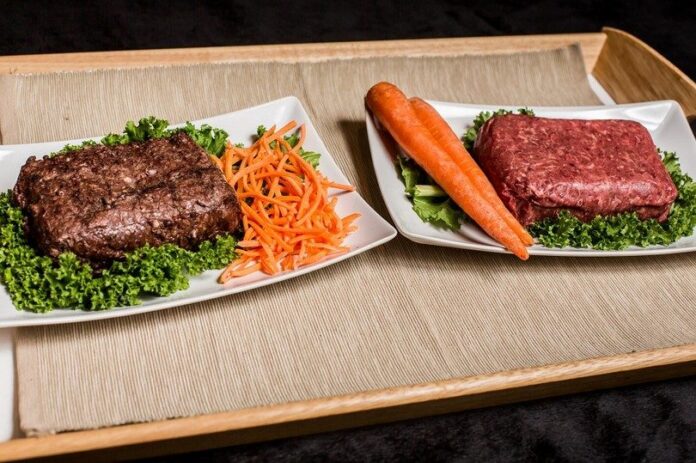
Another benefit of cooking food is that it kills germs and bacteria which may be present in the meat or vegetable. This is not a major problem with dogs though as they have stronger digestive acids which can kill these microorganisms and even digest bones and other tough materials.
It is only recommended for those who cannot bear to think of giving raw food to their pets or if their pets are not used to eating raw meat.
Raw dog food – Supporters of this type of pet food also have several bases in doing so. First, not cooking food helps to retain its essential nutrients such as enzymes, antioxidants, vitamins, and minerals. It also helps to maintain the natural moisture content of food which allows dogs to digest it much easier compared to cooked ones.
One of the best examples is meat bones. Cooking bones dehydrates them and makes them susceptible to splintering when chewed. Raw bones, on the other hand, are more pliable and digestible for dogs. They also retain their nutritional components better than cooked ones. This is also true in cooking vegetables or fruits.
To prepare raw dog food, you just need to toss the ingredients together and serve. This is highly recommended for those who cannot find the time to prepare their pet’s meals.
Main ingredients of a healthy dog meal
When preparing your pet’s dinner, it is important to consider its nutritional needs. Remember that their dietary needs are different than yours.
Dogs require a larger amount of calcium every day compared to humans and they also need more protein than carbohydrates.
Many times, pet owners think that vegetarian meals are the best for their pets since it provides a lot of health benefits in humans. The problem is that a dog’s digestive system is made for a carnivorous diet instead of an herbivorous one.
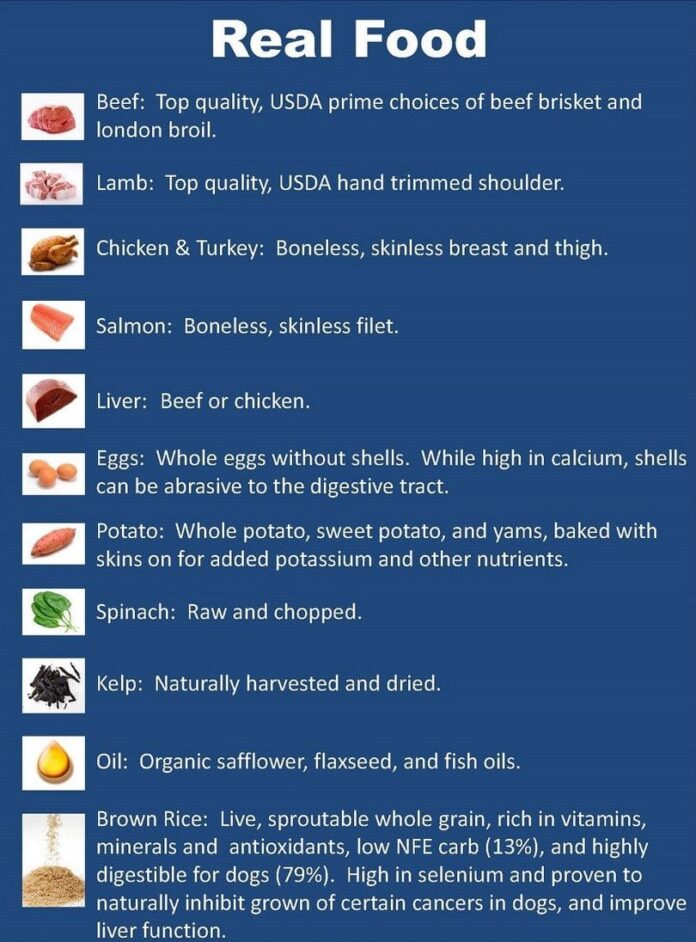
If you are going to study it, you will see that they have shorter intestines and they also lack in digestive enzymes suited for carbohydrates.
Animal protein
Since a dog is carnivorous, their main diet should consist in animal meat or protein. If you’re going to take a look at their diet while in the wild, you’ll realize that they eat the whole carcasses of their prey.
The recommended protein requirements are often based on daily percentages. Some diets require 75% meat while others only prescribe 50% of the overall meal. Dogs require a lot of protein for their overall growth and development.
Low protein diets often lead to musculoskeletal problems and degeneration of mental abilities in dogs. Sources of animal protein can range from beef, eggs, turkey, chicken, venison, lamb, wild game, bison, buffalo, and rabbits. Pork is not recommended for dogs since they contain a specific type of parasite which can produce adverse health effects in dogs.
Vegetables
This is the second most important ingredient in a dog’s diet where they derive essential micronutrients such as vitamins, minerals, phytonutrients, and enzymes. Pet owners are cautioned against using a large amount of vegetables since they lead to the formation of oxalates which eventually develops into kidney stones.
Some of the veggies that you can use in your dog’s diet include cabbage, celery, zucchini, squash, carrots, broccoli, and parsley. Eggplants, peppers, onions, beans, mushrooms, and garlic are not recommended due to their known adverse effects on dogs. You also need to cook them until soft or put them in a blender or food processor before feeding so that your dog can digest them easily.
Fruits, grains and starchy vegetables
These last ingredients are a good source of carbohydrates which dogs need for energy. They also provide vitamins and minerals which are essential for their biological functions. Take note not to give a lot of these foods to dogs since they can lead to diarrhea due to a large amount of fructose or it can cause unnecessary weight gain due to excess carbohydrates.
You also need to be careful about the type of grain that you feed your dog; make sure that they are not allergic to it. Stay away from grains that are commonly genetically modified such as corn and wheat. Some of the best that you can give are potatoes, sweet potatoes, carrots, couscous, and brown rice.
Fats and oils
Fats can be easily gotten from meat products and as for oil, you will have to find the healthier types. These two ingredients are what keeps your pet’s coat shiny and glossy and they also help provide some isolation from the cold. Chicken fat, in moderate amounts, is a good source of linoleic acid and fish oil is a high in omega-3 and omega-6 fatty acids.
You can use cod liver oil, olive oil, canola, and other healthy types of oil except for nut oils if your dog is allergic to them. You can add a teaspoon or two of these oils per meal either by cooking or mixing them in.
Supplements
Although this is not considered to be natural food, supplements help to provide additional nutrients which may not be gotten from whole foods. To make sure your pet is getting the nutrients they need, it is recommended to provide them with supplements such as calcium, phosphorus, magnesium, zinc, taurine, and vitamins.
Some recommend human supplements such as Centrum to be given at least once each day or you can buy supplements specifically made for dogs.
10 best homemade dog food recipes for your pet
To help you prepare your own homemade dog food recipes, we found some of the healthiest and most delicious ones. We have incorporated both cooked and raw recipes to help you choose or even try them out if you’re curious. The recommended meal servings per day, for a dog, will depend upon his breed, size, age, and health condition.
A puppy and lactating dog will require more calories as well as an adult dog. An average adult dog will need from 2 to 3% of his overall weight as a total daily meal serving. So if you have a 30-pound dog, that means he will need about 0.6 to 0.9 pound of dog food each day. The quantity can be increases if your dog is engaging in demanding or endurance activities.
1. Doggie beef stew
For this yummy recipe, you’ll need the following ingredients:
- 1 lb beef stew meat
- 1 small potato
- 1 small sweet potato
- ½ cup carrots, chopped
- ½ cup water
- ½ cup white flour
- 1 tbsp canola or olive oil
How to actually prepare it: Remove the skin from the potato and sweet potato and cut them into chunks. Bake the pieces in the oven for 8 minutes or until almost done. Next, heat the oil in a frying pan and sauté the beef stew pieces until they are cooked. Remove the beef and add water and flour slowly into the pan.

Continue stirring until the gravy gets thick and then add the beef, carrots, and potatoes. Keep it on the fire for 10 more minutes and it’s done. Your four legged companion will definitely be satisfied!
Turkey and vegetable dinner
To create this appealing recipe, the following ingredients are necessary:
- 1 pound turkey meat
- 1 cup cooked brown or white rice
- ½ cup green beans
- ½ cup carrots
- ¼ cup water
- 1 to 2 tbsp vegetable oil
The cooking procedure is quite simple: you only need to chop the turkey meat into pieces of desired size and stir-fry in oil until done. Add water, green beans, and carrots and cook for about 5 to 10 minutes. The final step is to mix in cooked rice and serve when the temperature is just right.
2. Doggie meat loaf
It sounds great, right? We’re sure your furry friend will also agree; just watch his reactions as the smell becomes greater and greater. Let’s start with the ingredients:
- 3 cups of your preferred type of meat
- 2 whole eggs
- ½ cup of grated or finely chopped vegetables
- ½ cup cottage cheese
- ½ cup rolled oats
Pre-heat the oven to 350 F and mix all the ingredients thoroughly in a bowl.
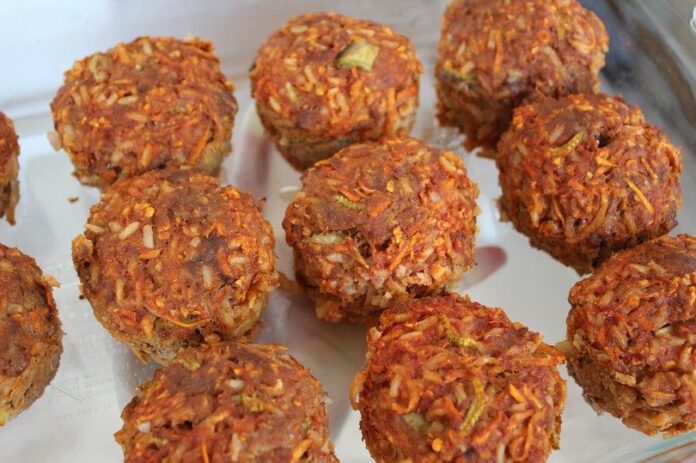
After this place them into a loaf pan and put the pan in the oven for about 35 to 40 minutes. When it’s done, simply slice into desired serving sizes.
3. Fish patty dinner
For this delicious recipe you’re going to need:
- 1 can of Salmon
- 1 medium-sized carrot
- 1 potato
- 1 egg
- 1 stalk of celery
- 3 tbsp flour
- Oil for frying
Cooking the recipe goes something like this: chop up the potatoes, celery, and carrot into bite-size pieces. Drain the salmon and mix it with flour and egg. The next step is to form the salmon into small patties and fry them in oil until they’re golden brown. After the patties are done, remove them from oil, and stir-fry vegetables for about 5 to 8 minutes. The patties are served with a side of vegetables.
4. Chicken casserole
The ingredients are easy to gather and the recipe tastes amazing (according to other dogs that have tried it). You will need:
- 2 chicken breasts
- 1 cup chopped vegetables (carrots, green beans, potatoes, broccoli)
- ¼ cup rolled oats
- 2 cups chicken broth
- Oil for frying
Start by chopping the chicken breasts into bite size pieces and sauté them in oil until cooked.
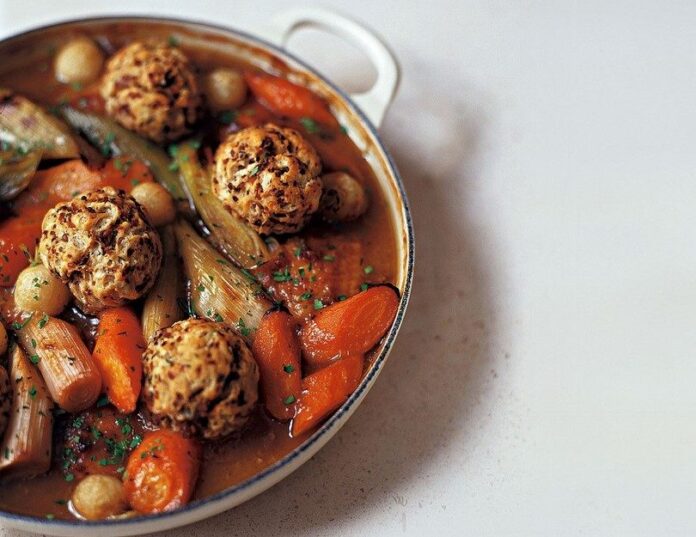
Add the chicken broth, rolled oats, and chopped vegetables in the pan and simmer from 10 to 15 minutes. Simple and absolutely delicious!
5. Sample raw dog food
For this you’ll need:
- 1 ½ cups of raw meat either beef, turkey, chicken, buffalo, venison, or lamb
- 1 cup mixed vegetables such as carrots, romaine lettuce, squash, and Brussel sprouts
- 1 tbsp cod liver oil
- 1 tablet supplement, powdered
- 2 tbsp bone meal or other similar calcium supplement
Chop up the raw meat into desired size pieces (you can use a grinder to get a finer mixture). Put all the vegetables in a blender or processor and blend until smooth. Next, take a large bowl and mix all ingredients together. Serve it to your furry friend and wait for impressions.
6. Basic dog food recipe
This is the kind of food you make when you can’t think of anything special for dinner or lunch. You’ll need the following:
- 1 cup ground meat
- ¼ cup liver either chicken or beef
- ½ cup cooked rice
- ¼ cup vegetables
- 1 hard-boiled egg
- 1 tbsp fish oil
Cook the ground meat until you don’t see any more pink. Mix in the liver, chopped boiled egg and vegetables and stir-fry until vegetables are done. Add the fish oil and rice and it’s ready to serve. Simple and efficient when the culinary inspiration is missing.
7. Homemade veggie smoothie
Note: This should only be served every other few days as dogs cannot thrive on a purely raw vegetable diet.
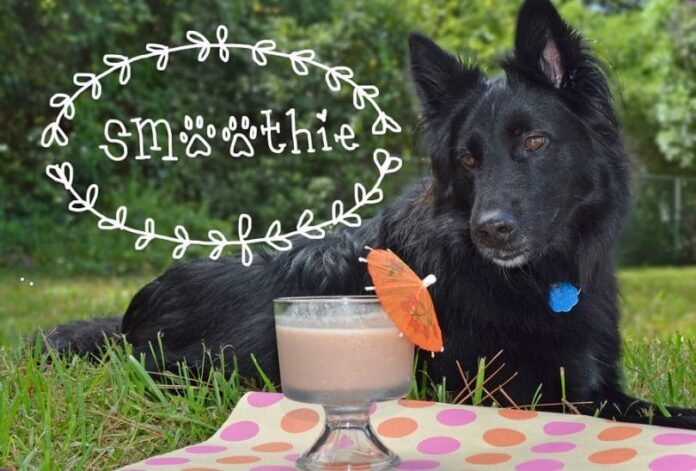
This delicious idea can be considered a small treat that you offer when your dog has behaved extremely well. You’ll need the following:
- ¼ cup of combined carrots, squash, zucchini, green beans, spinach, collards
- ¼ cup apples, peaches, pears, bananas
- ¼ cup fruit juice except for grape juice
- 4 tbsp yogurt
- 1 tbsp cream cheese
The procedure is super simple. Just combine all the ingredients in a blender and blend until smooth.
8. Raw fish dinner
We know it’s not too appealing for us (except if you like sushi) but for dogs this is quite tasty. The following ingredients are necessary:
- 2 pounds fish fillets
- 1 can pink Salmon
- 2 eggs
- 4 tbsp parsley
- 2 tbsp oregano
- 1 tbsp bone meal
- ½ cup cooked rice
Combine all the ingredients in a blender (except for the cooked rice). The next step is to add the rice (of course) and then serve under the form of tennis size balls.
9. Basic dog biscuits
Note: This should be used as a treat and not as a meal itself. Use it to reward your dog during training or when you are out in the park, playing.
This recipe requires the following ingredients:
- 2 ½ cups wheat or oat flour
- ½ cup chicken or beef stock
- 1 egg
- ½ cup bacon bits, cheese, or dehydrated chicken pieces
Start by pre-heating the oven at 350 F and continue by combining together the flour, stock, egg, and bacon bits (or chicken pieces).

Roll and form into dough. Flatten to a half-inch thickness and cut into desired shapes. Apply a small amount of grease into a cookie sheet and place in the cut-out dough. Bake for 25 to 30 minutes.
10. Doggie fruit dessert
Reminder: Never use grapes, raisins, macadamia nuts, or chocolate when making dessert for dogs.
We added this recipe as a bonus to this top 10 recipes. It’s delicious and your dog will be extremely happy (so double bonus!). Necessary ingredients:
- ¼ cup applesauce
- ¼ cup yogurt
- ½ cup blueberries
- ¼ cup strawberries
- ¼ cup diced apples
- 1 tbsp Brewer’s yeast (optional)
Combine all the ingredients in a blender and blend until smooth. That’s it!

As you can see, homemade recipes are not that difficult to make and we all know that your pet’s health should never be compromised by low quality ingredients as well as by added preservatives and additives.
There is a better way to ensure that your dog is getting the nutrition that they need by preparing their foods yourself.
You can choose from cooked meals which you can prepare with fresh ingredients or, if you don’t have the time, you can go for raw meals. Remember to add in vitamins and minerals through daily supplements or by adding bone meal to their food.
The easiest way to prepare your pet’s meals is to incorporate ingredients that you are using for your own meals. This way, your pet will enjoy the same nutrients that you enjoy without giving you added stress for meal planning.




